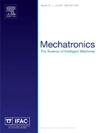Digital human model and training task planning-based adaptive assist-as-needed control for upper limb exoskeleton
IF 3.1
3区 计算机科学
Q2 AUTOMATION & CONTROL SYSTEMS
引用次数: 0
Abstract
To address the challenges of diminished motivation and increased fatigue observed in participants during active rehabilitation training, this study proposes a digital human model-based adaptive assist-as-needed (DHM-AAAN) control for an upper limb exoskeleton. This control framework consists of two main sub-controller loops: an outer sub-controller loop that determines the necessary assistive force, and an inner sub-controller loop which enables the exoskeleton to accurately replicate target movements while applying the assistive force derived from the outer sub-controller loop. Within the outer sub-controller loop, a strategy known as the digital human model and task performance evaluation (DHM-TPE) is employed to evaluate participants’ mobility capabilities and overall condition. Based on the assessment results, parameters such as radius, frequency, and assistive force are dynamically adjusted for multi-period trajectory tracking tasks through the implementation of an adaptive frequency oscillator (AFO) algorithm integrated with a digital human model. In the inner sub-controller loop, a barrier Lyapunov function-based hybrid force/position control with shifting error constraints (BLF-HCS) controller is introduced. This controller utilizes radial basis function neural networks (RBFNN) and error offset functions initialized with random values. The BLF constrains the exoskeleton’s tracking error, considering potential deviations from the desired initial position during the early phases of movement. To validate the effectiveness of the proposed controller, this study presents joint simulation results of the rehabilitation training cycle for circular task trajectories, experimental results from individual participants, and the average results from 6 participants.
基于数字人体模型和训练任务规划的上肢外骨骼自适应辅助控制
为了解决在主动康复训练中观察到的参与者动力下降和疲劳增加的挑战,本研究提出了一种基于数字人体模型的上肢外骨骼自适应辅助(DHM-AAAN)控制。该控制框架由两个主要的子控制器环组成:一个外部子控制器环决定必要的辅助力,一个内部子控制器环使外骨骼能够准确地复制目标运动,同时应用来自外部子控制器环的辅助力。在外部子控制器回路中,采用数字人体模型和任务绩效评估(DHM-TPE)策略来评估参与者的移动能力和整体状况。基于评估结果,通过实现与数字人体模型相结合的自适应频率振荡器(AFO)算法,对多周期轨迹跟踪任务的半径、频率和辅助力等参数进行动态调整。在子控制器内环中,引入了一种基于barrier Lyapunov函数的带移位误差约束的混合力/位置控制(BLF-HCS)控制器。该控制器采用径向基函数神经网络(RBFNN)和随机初始化误差补偿函数。考虑到在运动的早期阶段与期望初始位置的潜在偏差,BLF限制了外骨骼的跟踪误差。为了验证所提出控制器的有效性,本研究给出了圆形任务轨迹的康复训练周期联合仿真结果、个体参与者的实验结果以及6名参与者的平均结果。
本文章由计算机程序翻译,如有差异,请以英文原文为准。
求助全文
约1分钟内获得全文
求助全文
来源期刊

Mechatronics
工程技术-工程:电子与电气
CiteScore
5.90
自引率
9.10%
发文量
0
审稿时长
109 days
期刊介绍:
Mechatronics is the synergistic combination of precision mechanical engineering, electronic control and systems thinking in the design of products and manufacturing processes. It relates to the design of systems, devices and products aimed at achieving an optimal balance between basic mechanical structure and its overall control. The purpose of this journal is to provide rapid publication of topical papers featuring practical developments in mechatronics. It will cover a wide range of application areas including consumer product design, instrumentation, manufacturing methods, computer integration and process and device control, and will attract a readership from across the industrial and academic research spectrum. Particular importance will be attached to aspects of innovation in mechatronics design philosophy which illustrate the benefits obtainable by an a priori integration of functionality with embedded microprocessor control. A major item will be the design of machines, devices and systems possessing a degree of computer based intelligence. The journal seeks to publish research progress in this field with an emphasis on the applied rather than the theoretical. It will also serve the dual role of bringing greater recognition to this important area of engineering.
 求助内容:
求助内容: 应助结果提醒方式:
应助结果提醒方式:


